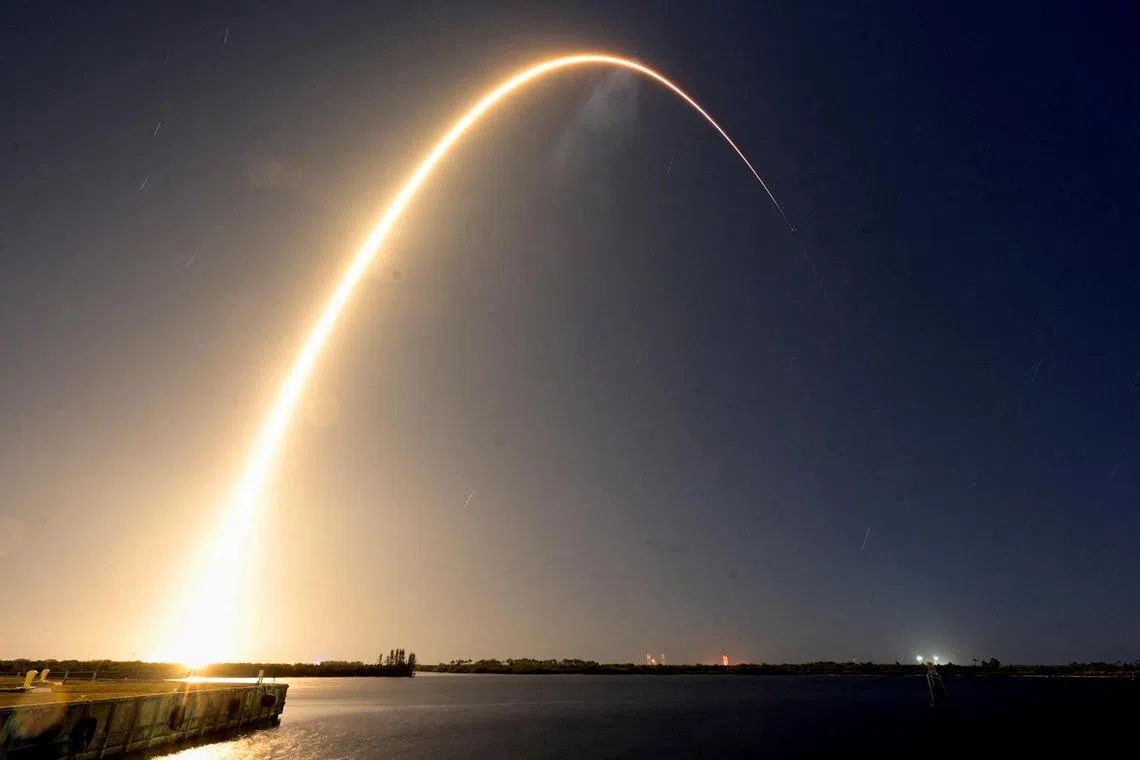In a first, private US spaceship lands upright on Moon
Sign up now: Get ST's newsletters delivered to your inbox

The first image from the lander revealed the rocky, pockmarked terrain it had to autonomously navigate in order to select its touchdown spot.
PHOTO: AFP
Follow topic:
WASHINGTON - A US company successfully landed its spacecraft on the Moon on March 2, marking only the second private mission to achieve the milestone – and the first to do so upright.
Firefly Aerospace’s Blue Ghost Mission 1 touched down shortly after 3.34am US Eastern Time near Mons Latreille, a volcanic formation in Mare Crisium on the Moon’s north-eastern near side.
“Y’all stuck the landing, we’re on the Moon,” an engineer at mission control in Austin, Texas, called out as the team erupted in cheers.
Chief executive Jason Kim confirmed that the spacecraft was “stable and upright” – in contrast to the first private landing last February, which came down sideways.
“We’re on the Moon!” associate administrator Nicky Fox for Nasa’s Science Mission Directorate rejoiced.
The first image from the lander revealed the rocky, pockmarked terrain it had to autonomously navigate in order to select its touchdown spot, having slowed down from thousands of miles per hour to just two mph (3.21kmh).
Nicknamed “Ghost Riders in the Sky”, the mission is part of a Nasa-industry partnership aimed at reducing costs and supporting Artemis, the programme designed to return astronauts to the Moon.
The golden lander, about the size of a hippopotamus, launched on Jan 15
It shared a ride with a Japanese company’s lander set to attempt a landing in May.
Blue Ghost carries 10 instruments, including a lunar soil analyser, a radiation-tolerant computer and an experiment testing the feasibility of using the existing global satellite navigation system to navigate the Moon.
Designed to operate for a full lunar day (14 Earth days), Blue Ghost is expected to capture high-definition imagery of a total eclipse on March 14, when Earth blocks the Sun from the Moon’s horizon.
On March 16, it will record a lunar sunset, offering insights into how dust levitates above the surface under solar influence – creating the mysterious lunar horizon glow first documented by Apollo astronaut Eugene Cernan.
Hopping drone
Blue Ghost’s arrival will be followed on March 6 by fellow Texas company Intuitive Machines’ IM-2 mission, featuring its lander Athena.
In February 2024, Intuitive Machines became the first private company to achieve a soft lunar landing
However, the success was tempered by a mishap: the lander came down too fast and tipped over on impact, leaving it unable to generate enough solar power and cutting the mission short.
This time, the company says it has made key improvements to the hexagonal-shaped lander, which has a taller, slimmer profile than Blue Ghost, and is around the height of an adult giraffe.

The Blue Ghost lunar lander launched on Jan 15 on a SpaceX Falcon 9 rocket.
PHOTO: REUTERS
Athena launched on Feb 26 aboard a SpaceX rocket, taking a more direct route toward Mons Mouton – the southernmost lunar landing site ever attempted.
Its payloads include three rovers, a drill to search for ice and the star of the show: a first-of-its-kind hopping drone designed to explore the Moon’s rugged terrain.
Nasa’s private Moon fleet
Landing on the Moon presents unique challenges due to the absence of an atmosphere, making parachutes ineffective.
Instead, spacecraft must rely on precisely controlled thruster burns to slow their descent.
Until Intuitive Machines’ first successful mission, only five national space agencies had accomplished this feat: the Soviet Union, the United States, China, India and Japan, in that order.
Now, the United States is working to make private lunar missions routine through Nasa’s US$2.6 billion (S$3.5 billion) Commercial Lunar Payload Services programme.
The missions come at a delicate moment for Nasa, amid speculation that it may scale back or even cancel its Artemis lunar programme in favour of prioritising Mars exploration – a key goal of both President Donald Trump and his close adviser, SpaceX founder Elon Musk. AFP

